Insulin level (Insulin Assay)
Insulin level
What sample is needed for Insulin level?
- This test is done on the serum of the patient.
- A fasting sample is preferred.
- Freeze the sample.
- With OGTT, draw a fasting sample at 30, 60. and 120 minutes.
- Avoid hemolysis.
What are the Indications for Insulin level?
- It helps in the management of glucose metabolism.
- Insulin level helps in the diagnosis of insulinoma.
- Insulin levels can be advised in starting the initial therapy for patients with type 2 Diabetes Mellitus.
- In the case of lower insulin levels, insulin or an insulin secretagogue is the most adequate treatment.
- Insulin level is advised in case of fasting hypoglycemia.
- It helps patients with diabetes requiring insulin as treatment and patients who can control it with diet only.
- Advised in the case of abnormal carbohydrate and lipid metabolism.
- Insulin was recently advised in case of polycystic ovary syndrome.
- Ladies with this disease have insulin resistance and abnormal carbohydrate metabolism that may respond to oral hypoglycemic agents.
- Insulin is not clinically advised for the diagnosis of diabetes mellitus.
- People were estimating insulin levels in OGTT to help early diagnose diabetes mellitus.
What are the precautions for insulin levels?
- Keep in mind that insulin antibodies can interfere with radioimmunoassay.
- The patients treated with insulin develop antibodies.
- Obesity and food may increase insulin levels.
- Radioisotopes, if given before the test, will affect the result.
- Drugs like corticosteroids, oral contraceptives, and levodopa increase insulin levels.
How will you define Insulin level?
- Total insulin measures free and bound insulin.
- Insulin keeps glucose levels under control.
- It is an islet cell, an anabolic hormone that controls glucose uptake, fat, and protein synthesis.
- It is a protein hormone produced by the beta cells of islets of Langerhans in the pancreas.
- Its molecular weight is 6000 D and consists of 51 amino acids.
- It has two amino acid chains, A and B, joined by the disulfide bridge.
- Insulin in humans is similar to insulin in animals.
- Now, most patients are treated with human recombinant insulin.
What is the mechanism for Insulin formation?
- Insulin forms from inactive preproinsulin, consisting of 100 amino acids. It is not found in the blood.
- Preproinsulin converts into proinsulin (big insulin) which cleaves by the proteolytic enzymes.
- Proinsulin consists of alpha and beta chains connected by an area called a connecting peptide (C-peptide).
- There is the formation of insulin and C-peptide.
- C-peptide has no insulin-like action but can be measured to assess the β-cell function.
- Insulin is stored in secretory granules, and when plasma glucose is increased, insulin is released by exostosis.
- Insulin half-life is 10 to 25 minutes (another reference is 4 to 9 minutes).
What are the functions of insulin?
How Insulin will regulate carbohydrate metabolism?
- Insulin maintains blood glucose at a constant level within the defined normal range.
- Insulin facilitates the movement of glucose from the bloodstream into the cell.
- Insulin is the anabolic hormone that stimulates glucose uptake into the fat and muscles.
- Insulin promotes the conversion of glucose into glycogen or fat storage.
- Insulin inhibits glucose production from the liver.
- Insulin stimulates protein synthesis and inhibits protein breakdown.
- The insulin level secretion is dependent upon the level of glucose.
What is the effect of starvation and fasting on Insulin secretion?
- Glucose decreases in the first three days of the fast at around 18 mg/dL.
- Glucagon secretion is doubled to maintain the glucose level.
- Lipolysis and liver ketogenesis are stimulated.
- Ketone bodies, fatty acids, and glycerol levels in the blood are increased.
- Initially, triglyceride increases and later decreases.
- Cholesterol also decreases.
- Due to catabolism in starvation, the concentration of the protein in the blood increases.
- There are chances to develop metabolic acidosis.
- Reduced blood pH.
- Reduced pCO2.
What is the effect of OGTT and fasting glucose on insulin?
- There are suggestions that insulin level on the same sample with OGTT level is more reliable than a single insulin level.
- Patient with Juvenile diabetes has a typical picture in OGTT:
- Low fasting insulin level and display flat GT insulin curve.
- This shows that there is no increase in the insulin level.
- Patients with mild diabetes mellitus show:
- Normal fasting insulin level.
- GT curve with a delayed rise in insulin.
- Patients with diabetes mellitus type 2 show:
- Fasting insulin level is normal, but the insulin’s response to glucose is delayed.
- Insulinoma has a characteristic picture of the fasting glucose level and insulin level.
- There is increased insulin with low fasting glucose.
- Persistent hypoglycemia with an increased insulin level.
- The insulin/glucose ratio should be less than 0.3.
- The insulin/fasting glucose ratio in Insulinoma is more than 0.3.
How will you calculate insulin level using Turner’s amended formula?
- When the glucose level increases, the insulin level also increases. When the glucose level decreases then, insulin secretion stops.
- Insulin levels will be low in Insulin-dependent diabetes mellitus.
- While insulin levels are high in non-insulin-dependent diabetes mellitus due to insulin resistance, the patient needs more insulin.
Insulinoma:
How will you give important facts about Insulinoma?
- This is the tumor of beta cells in the islets cells of Langerhans of the pancreas.
- There is persistent hypoglycemia, which may be below 30 mg/dL.
- There is a raised level of insulin.
- There is a persistently high level of C-peptide.
- The Turner (modified) insulin/glucose ratio is above 50.
What is important about insulinoma?
- Insulinomas are the tumors of Beta-cells insulin-producing pancreatic islet cell tumors.
- About 80% of these tumors are single adenomas, about 10% are multiple, and about 10% are carcinomas.
- Insulinomas are typically associated with hypoglycemia.
How to diagnose Insulinoma?
- Diagnosis of islet cell tumors is important.
- Whipple’s triad for the diagnosis of insulinoma:
- Symptoms are compatible with hypoglycemia while fasting.
- A fasting blood glucose level is important while the patient is having symptoms. This may be as low as 10 mg/dL (0.55 mmol/L).
- The patient’s symptoms improve when he/she is given glucose.
- It is required to find the insulin level which is elevated.
- Plasma or serum insulin/glucose ratio.
- In the active insulinoma, insulin level will be elevated.
- Amended ratio of insulin/glucose ratio.
- Serum insulin level x 100 / Serum glucose – 30 mg/dL.
- Such a ratio of >50 is suggestive of Insulinoma.
- Tolbutamide test.
- A special water-soluble form of tolbutamide is given intravenously.
- In a normal person, there is a rapid fall in the glucose level in 30 to 40 minutes, followed by a return to normal level in 1.5 to 3 hours.
- In patients with insulinoma, glucose levels rapidly fall compared to the normal person (40% to 65% of the baseline).
What is the Normal insulin level?
Source 1
Insulin free
- Infants and prepubertal child = <13 µU/mL
- Prepubertal child and adult = <17 µU/mL
- To convert into SI units x 6.945 = pmol/L
- Insulin immunoreactive
- 2 to 12 year = <10 µU/mL
- Adult = <35 µU/mL
- Insulin with oral glucose tolerance test
- 0 minute = 3 to 28 µU/mL
- 30 minutes = 20 to 112 µU/mL
- 60 minutes = 29 to 88 µU/mL
- 120 minutes = 22 to 79 µU/mL
- 180 minutes = 4 to 62 µU/mL
Source 2
- Adult = 6 to 26 µU/mL (43 to 186 pmol/L)
- Newborn = 3 to 20 µU /mL
- Possible critical value = >30 µU/mL
What are the conditions where there is an Increased Insulin level?
- Insulinoma.
- Fasting insulin level is >50 µU/mL in the presence of normal or low blood glucose.
- Insulin autoimmune syndrome.
- Acromegaly.
- There are raised glucose levels.
- The overproduction of growth hormone in these patients gives rise to constant stimuli for insulin production.
- Cushing’s syndrome.
- There is a raised level of glucose due to the overproduction of cortisol.
- There is constant stimulation for the production of insulin.
- Pancreatic islet cell hyperplasia.
- Obesity. There is a constantly raised level of insulin.
- Fructose or galactose intolerance.
- Cirrhosis occurs when there is insufficient clearance from the blood circulation.
What are the conditions where insulin level is decreased or absent?
- Diabetes mellitus type 1 (maybe a total lack or very low).
- In diabetes mellitus type 2, there is a low insulin resistance level.
- In the case of severe diabetes mellitus with ketosis and weight loss.
- In less severe cases of diabetes, insulin is present but at a lower glucose level.
- Hypopituitarism.
- Critical Value of Insulin = >30 mU/mL
Questions and answers:
Question 1: What will be the level of insulin in insulinoma.
Question 2: What is the relation of blood glucose level and insulin level.

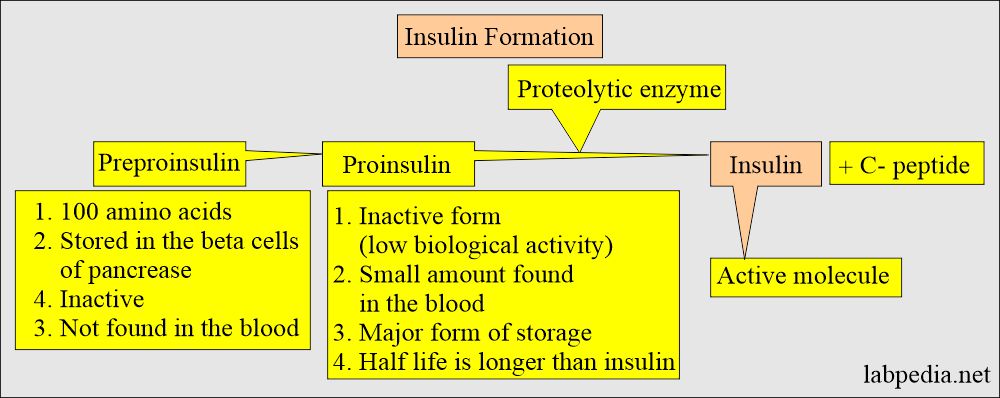
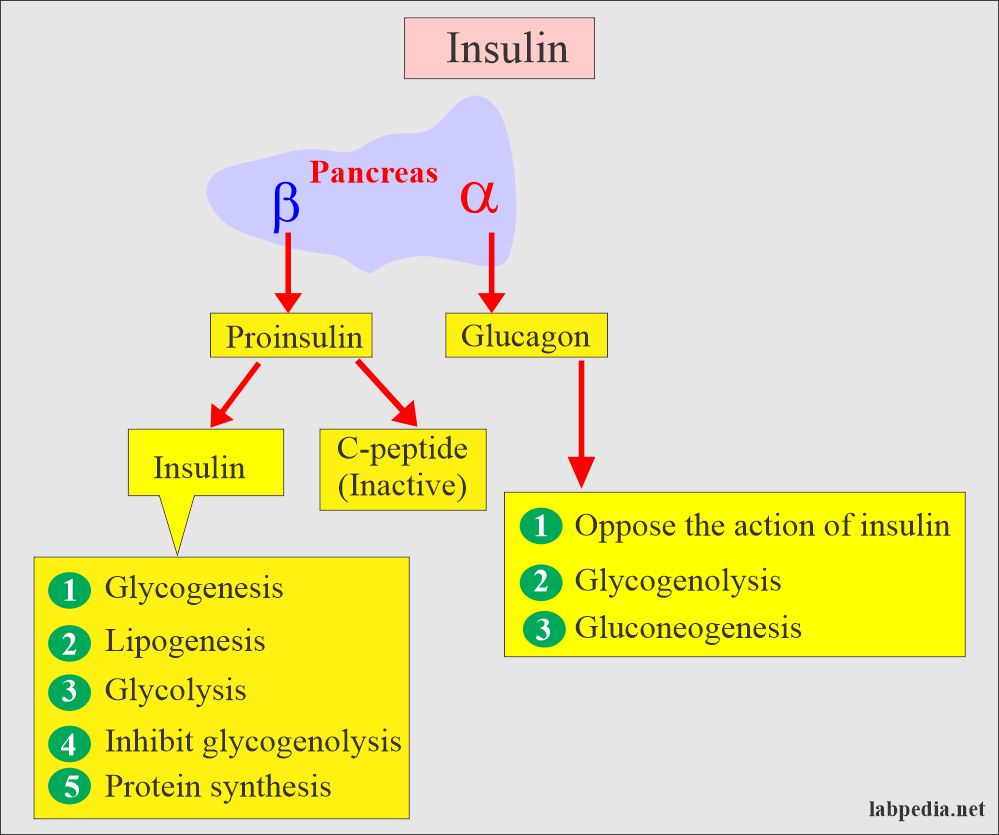
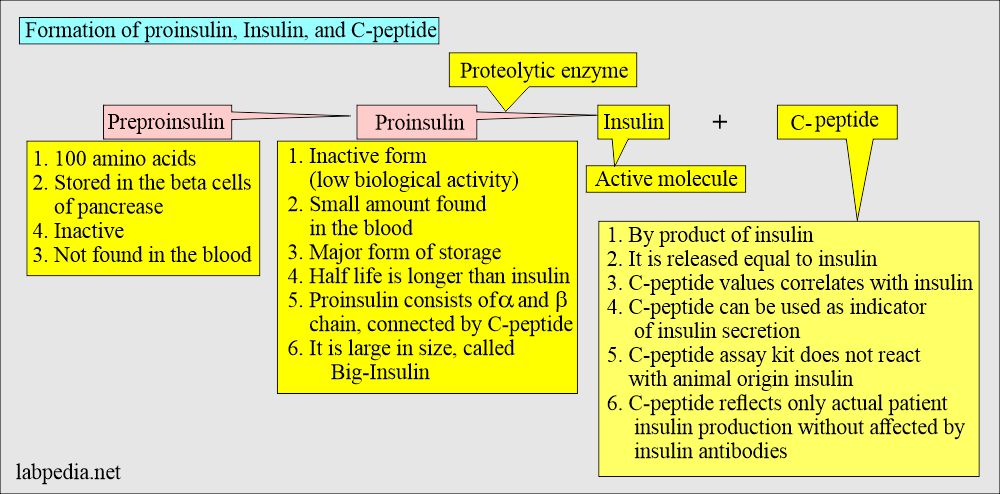
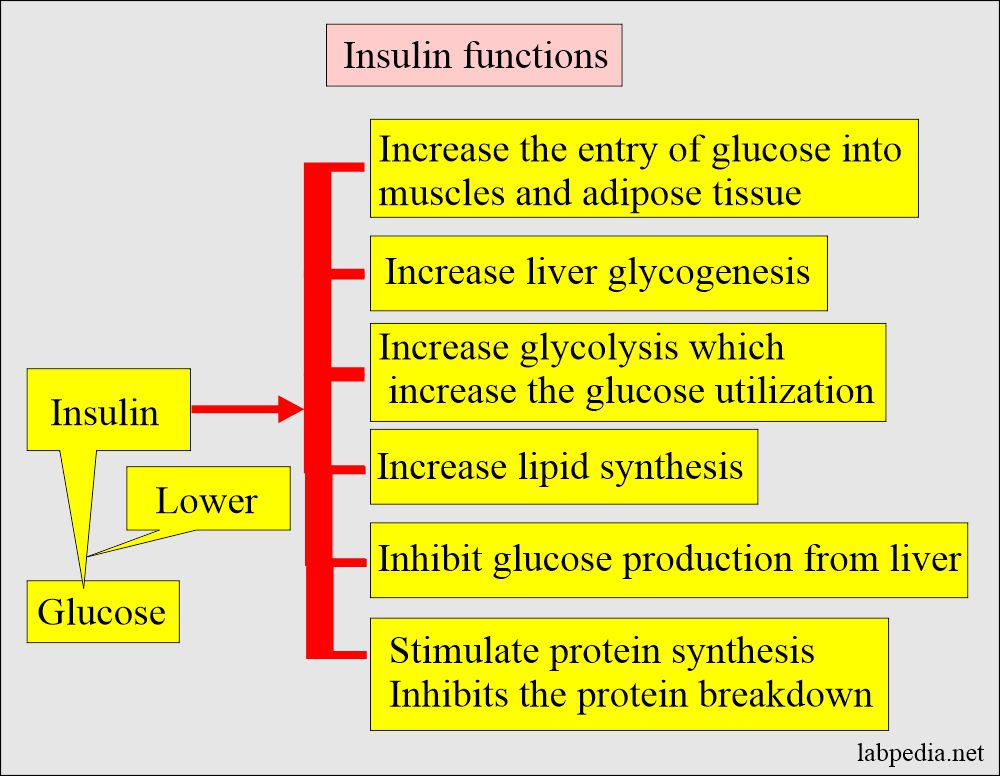
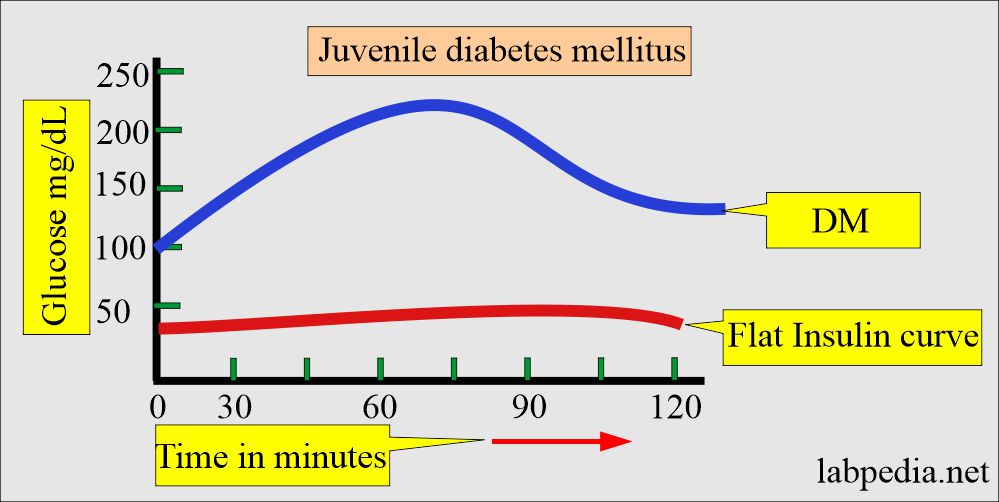
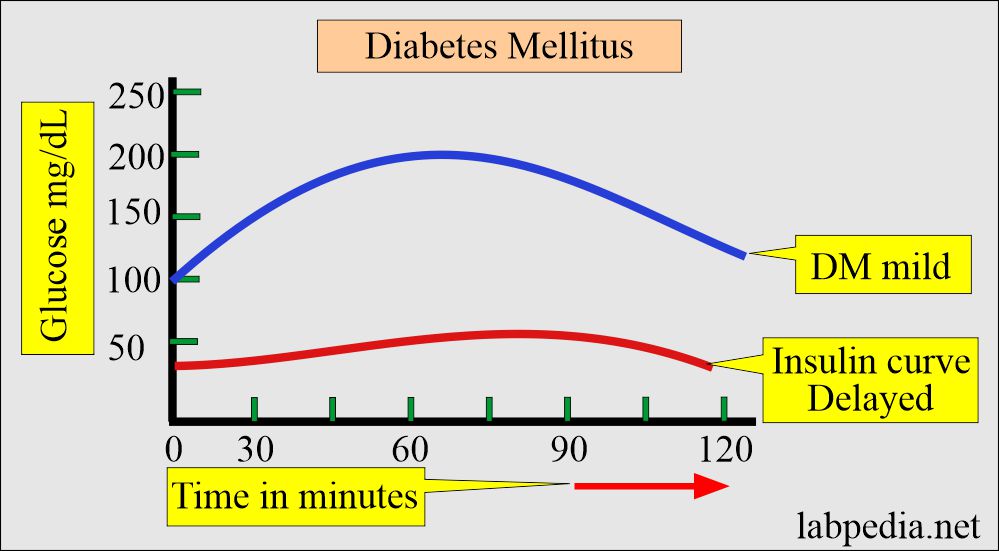
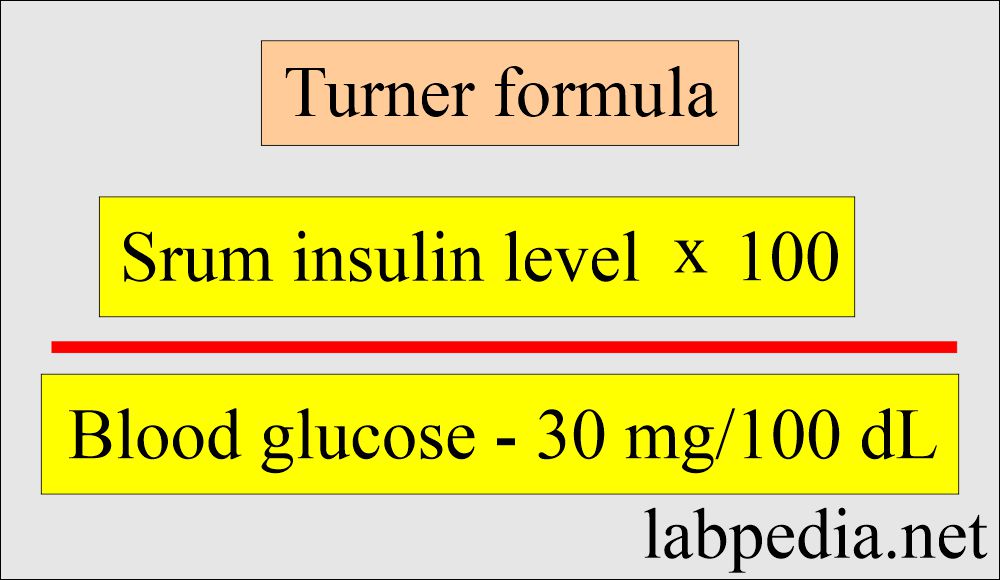
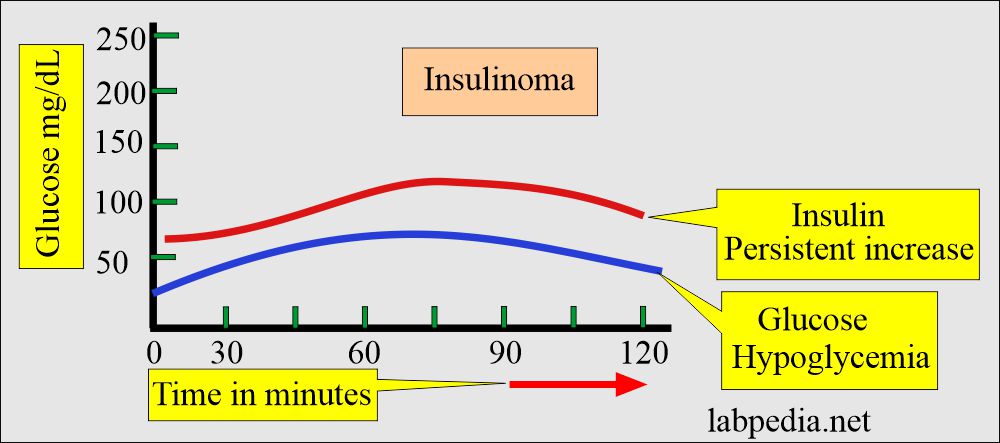
thank you